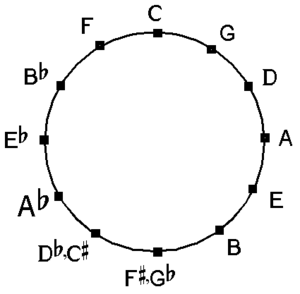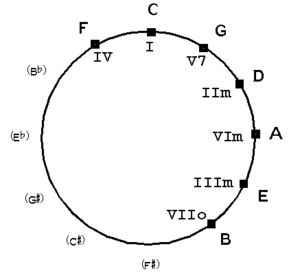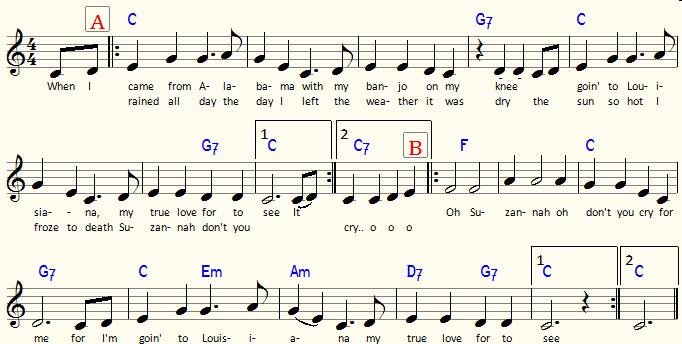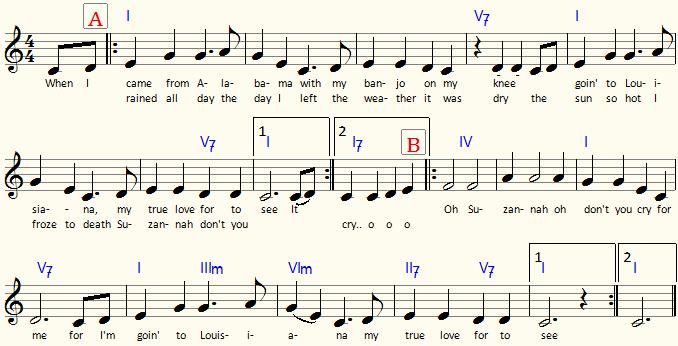Circle of fifths
The so called Circle of fifths is what you will 'discover' when you start experiencing the question and answer, tense and release feeling of a dominant-seventh chord resolving to its corresponding tonic chord.
As starting guitar player you'll find that the chord sequence D7 → G provides a strong question (D7) - asking for the ultimate answer (G). Practicing guitar chords you'll find more of those chord duo's representing the same effect (E7 → A, C7 → F, G7 → C etc.)
If we arrange those chords such that each question (the dominant seventh) chord is followed by its answer chord (the tonic) as a new seventh chord you get a sequence like
...B7 → E7 → A7 → D7 → G7 → C7 → F7 → Bb7...
Extending the range, ignoring enharmonic exchange and folding the sequence to a circle, we get the Circle of fifths:
Each step to the left on the circle represent a musical fifth (7 semitones) and represents the strong pull of harmony in that direction.
Chords
When using chords, the Circle of fifths will be one of your most valuable resources to help you understand what's going on:
In the diagram above the circle was rewritten mentioning the stage within the major scale of C using seven stages C D E F G A B.
Take a close look to the chords in the song below.
It starts with the C chord (stage I) and moves on to the G7-chord (stage V) as soon as the chord on I does not 'fit' anymore. One bar later we're back at I; the G7 pulls strongly back to the C-chord, we're at home again.The melody alters a bit and the chord sequence C G7 C repeats. The [A] part repeats, using two more C G7 C chord sequences.
Then (at o-o-o ) The C-chord is replaced with a C7 that very strongly pulls to the F-chord. In many songs the the chord at stage IV - left of stage I on the circle - is the chord needed to complete the minimal harmonization of most songs.
Two bars of F and one more C G7 C sequence later we meet a Em-chord (as replacement of the simpler G7) and a sequence Em Am D7 G7 C. Wow!
On the circle you see a journey of counterclockwise steps known to pull the melody inescapably forward to the end.
Looking carefully to the chords of catchy melodies (like many evergreens), you will find heaps of sequences like this one.
When we should rewrite the song using notation with stages we get:
Tricks and treats of the Circle of fifths.
The Circle of fitfhs has many uses, some obvious, some hidden:
- Neighboring keys are just one sharp or flat apart: going one step to the right means add one sharp, going to the left add one flat (or remove one sharp). So, starting at C-major (top of circle) the key to the right of C right has one sharp, the key left of C has one flat
- The chords immediately clockwise from the three main chords IV I V7 are the relative minor chords IIm VIm IIIm. If you need more than the main major chords, here they are for use.
- Minor and major keys of the same note (D and Dm, A and Am) are located a quarter of a circle apart, and thus any major key has three sharps more than the corresponding minor key. A-major has 3 sharps, whereas A-minor has none, D-major has two sharps whereas D-minor (with its relative major F) has one flat (adding a flat equals removing a sharp).
- Whenever you need a strong pull to the dominant seventh (the V7) just look at the circle and use the seventh chord on the II7; it will urge you to the V7 (if the melody allows, because a II7 contains an out-of-key note - in the example above the D7 contains an f# instead of an f)
- Each whole step up (one whole tone) is two steps clockwise and thus adds two sharps (or removes two flats- boils down to the same thing).
- Clockwise, each step represent a fifth (C-G), counterclockwise a fourth (C-F) The Circle of fifths might equally valid be called Circle of fourths
In MusiCAD you'll encounter the Circle of fifths when transposing a tune. The chord wizard also uses the Circle of fifths behind the scenes.




